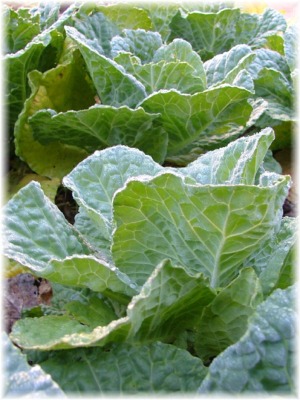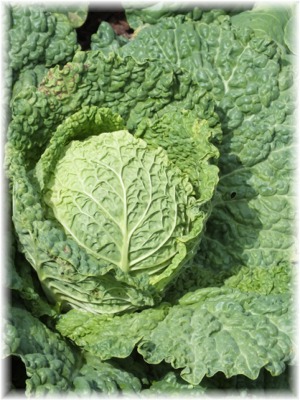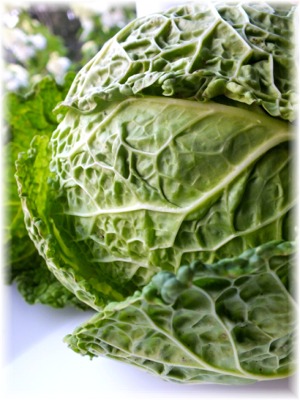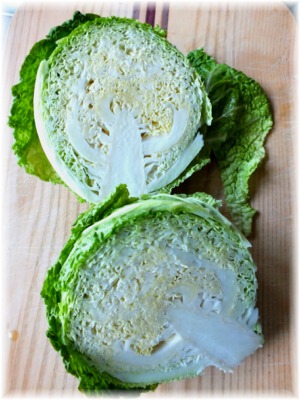Though we have yet to find a baby in a Cabbage patch, it's easy to understand what inspired this tall tale. Walk down a row of Cabbages and you'll see them, like giant flowers, each gently swaddling its perfect interior orb. It's a fitting introduction to Alcosa Baby Cabbage, an adorable half-size savoy Cabbage with crinkly, dusky-blue outer leaves, a lime-green head and a buttery yellow interior. Cabbage perfection! Alcosa's leaves are mild and tender with a texture similar to Radicchio. Thinly sliced, they are a perfect alternative to Lettuce in summer salads, make fantastic coleslaw and are scrumptious braised in butter with a little fresh Thyme. The 6" heads are ready to harvest in just 65 days~perfect for a midsummer planting. You'll then enjoy months of crunchy autumn salads with shredded apples and toasted walnuts.

The Lowly Cabbage Gets Its Due
Cabbages have sustained many a family through hard times. They are nutritious, inexpensive and store for months. Unfortunately, these serviceable qualities have long obscured the Cabbage's essentially delicious nature. Thanks to Alcosa Baby Cabbage, our eyes were opened to an exciting new world of Cabbage love. Now we understand why top chefs consider Cabbage~ especially Savoy Cabbage~a gourmet ingredient. What's more, Cabbage is a nutritional powerhouse of Vitamins C and K, folic acid, fiber and cancer-fighting anthocyanins.
Alcosa Baby Cabbage stars in one of our favorite summer side dishes: Lemony Sautéed Cabbage. Core a small Savoy Cabbage and slice it very thinly. Heat 2 tablespoons of extra virgin olive oil over medium high heat in a large heavy skillet. Add half the sliced Cabbage and ½ teaspoon salt, and sauté while stirring frequently until very tender and browned in some places. Remove from the pan and repeat with the second half of the sliced Cabbage. Return all of the sautéed Cabbage to the skillet, and mix in one 15 ounce can of drained, rinsed chickpeas, ¾ cup of bright green pitted Castelvetrano or Cerignola olives, ½ cup toasted pecans, 1 lemon (use its zest and juice), and 1/3 cup chopped fresh Dill leaves. Season to taste. Even better for lunch the next day!

How to Grow a Beautiful Cabbage
For best results, transplant Cabbage into the garden as 4 to 6 week old seedlings. Start the seeds indoors, planting 2 or 3 seeds per pot in moist, sterilized seed starting mix, and then thinning to one plant per pot. Give the seedlings 12 to 15 hours of bright light each day (in a greenhouse or under fluorescent lights). When the plants have two sets of true leaves, begin preparing them for life in the garden. Put them in a sheltered outdoor location for a few hours each day and gradually lengthening the time in full sunlight. Do this for 7 to 10 days, until the plants are acclimated.
Young Cabbage plants will tolerate chilly temperatures and can be planted outdoors up to 4 weeks before your last frost-free date or 8 weeks before your first fall frost. (To find the Frost-Free Date for your garden, go HERE and use the National Oceanic and Atmospheric Administration (NOAA) chart. Select your State from the pull down menu and the select the local NOAA data collection site closest to your garden from the PDF file.)
Cabbages have "kingly" appetites, so be sure to feed them well. Choose a sunny, well-draining planting area and prepare the soil by loosening it with a fork and adding plenty of well-rotted manure and/or compost and all-purpose organic fertilizer (following package directions). Placing a lightweight floating row cover over young transplants as soon as you set them out will protect them from the flying insects that could later become root maggots and those pesky green Cabbage worms. The covers let in plenty of light, air and water, and can be left on (except for weeding) until the plants are mature enough to fend for themselves.
During the summer, water your Cabbage plants as needed and fertilize monthly until the heads start to develop. Cabbage tastes best when harvested in its prime, while the heads are still relatively small and tightly wrapped. We always plant more Cabbage than we can eat, as it keeps well until Christmas in a cold basement or the back of a refrigerator. When harvesting for winter storage, keep the stem and roots attached to extend storage life.

Copious Cabbage Choices
Gonzales Baby Cabbage yields attractive, uniform one pound 6" round cabbages that look like lustrous, blue-green softballs. Its dense, firm heads resist splitting and have a particularly sweet flavor and a crisp, crunchy texture. Primero Red Cabbage produces two to four pound compact, dense, dark red heads, that have unsurpassed, sweet taste and tender texture. Our new Purple Savoy Cabbage is a prized, early-heading Cabbage that bestows us with dense, solid orbs that are as beautiful as they are deliciously sweet. Normally growing from 1- to 3-pounds, its blushed purple and pale green heads have artistic, intricately savoyed, crinkled leaves. Caraflex Pointed-Head Cabbage features lovely little cone heads weighing in at just 1 1/2 to 2 pounds. A hands-down trial favorite, Caraflex holds well in the garden, has extra crunch and sweetness and stores up to 8 weeks after harvest. Last but not least is our classic heirloom Late Flat Dutch Storage Cabbage introduced to America with the first European settlers, Long-season Late Flat Dutch matures into smooth, oval, rock-hard heads up to 12" across and up to 15 pounds. The world's premier storage cabbage, it keeps in the root cellar or crisper in the fridge for months.

Cabbage Goes Gourmet
Cabbage may not have the intrigue of wild ramps or the preciousness of Pea sprouts, but creative chefs are finding exciting new ways to use this humble vegetable. Try to imagine a fish taco without a zippy Cabbage slaw on top! We like Chef Allison Martin's Simple Cabbage Slaw that she serves at The Burning Tree in Otter Creek, Maine. It calls for one small head of savoy Cabbage shredded extra fine, tossed with two grated Carrots, a finely-sliced small Red Onion, one minced Hot Pepper, 1/3 cup chopped Cilantro and ¼ cup chopped Mint. Top with the juice of two squeezed limes, ¼ to ½ cup good extra virgin olive oil and salt and pepper to taste. Let it marinate at least 15 minutes before serving. Prefer your Cabbage Slaw creamy? Just use equal parts good mayonnaise and Greek yogurt with sugar and apple cider vinegar to taste.



